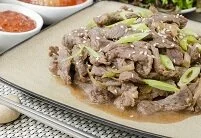Dining Etiquette

Beef bulgogi
Social protocol in South Korea dictates that your local host meets you at a place you can easily find, then will escort you to their residence or a restaurant. Try to arrive at your meeting point on time, and if you are going to a local's house, be sure to remove your shoes upon arrival. Once in the door, greet every person individually.
Wait to be shown a seat as seating arrangements may be pre-arranged or dictated by social standing and seating yourself in the incorrect location may embarrass your host, despite the fact that he may say nothing. Once at the table, there will most likely be a plate, small plate, chopsticks, and perhaps a spoon. The small plate is essentially a "discard tray," on which you should place bones, shells, etc. The chopsticks are obviously for eating the food and you may want to become accustomed to using these before arrival as touching food with your hands is off limits. When offered any dish, do accept it as turning down food is quite rude.
The oldest person present should begin dining, so wait until invited to begin eating or until everyone else is clearly already eating. If served both rice and a spoon, eat the rice with the spoon. Unlike many Far East countries, don't bring the rice or soup bowl up to your mouth, but leave these on the table itself. If you are being served drinks, which may or may not be the case, fill the glass of those around you and let them fill your glass (although women should not fill other women's glasses). If drinks are served with food, it tends to be either tea or water, rarely is it an alcoholic beverage.
Throughout the course of the meal, if you decide to take a drink or even speak to those around you, put your chopsticks down. Although this may mean trying to renegotiate your chopsticks dozens of times during a meal, it's the best course of action. If you want a second helping, refuse initially and only after your host's insistence should you accept. When you do finally finish eating, place your chopsticks back on your chopstick rest and eat ever last grain of rice. In many households you're expected to leave a little food on your plate (but finish the rice), while in restaurants it is more common to finish everything.
If dining out, the person who initiated the meal should pay for everyone. All others should make an effort to pay, but this will be refused. As the meal began, your host will most likely walk you out to a point that you are familiar with so you are sure to return safely; don't expect to be left at the door. If you dined at a local's home, be sure to send a thank you note the following day.
There is no tipping in South Korea and offering a tip can be an insult. This trend is slowly changing in some western restaurants and hotels, but is not yet common.
Celebrations & Events
Most traditional Korean foods associated with celebrations are served for important personal events, including birth, weddings, funerals, and other important personal events. During these events differing foods are served.
At birth foods are generally served in sets of three as that is considered a lucky number. These foods include rice and sea mustard soup among others. These same foods are also served on later celebrations like the Coming of Age Ceremony (gwan rye), but at this festival rice wine, rice cakes, kimchi, noodle soup, and additional foods are served to celebrate this event.
At weddings rice wine, rice cakes, chicken, and numerous other traditional dishes are served. At funerals alcohol and the head meat of a pig or cattle is served; red chili pepper is also served at funerals as it is believed to expel ghosts.
Drinks
The South Koreans cling to a number of traditional drinks, like ginseng, ginger, and fruit drinks, but tea is quickly growing in popularity. For one of most authentic drinks however, skip these options and reach for sikhye, a sweet rice drink.
Beers and rice wines are common in South Korea for everyday drinking, but their most local beverage is soju, which is a liquor distilled from rice or another starch, such as barley or sweet potatoes.
Generally speaking, the tap water is safe to drink in South Korea, but check with locals for any particular regional differences. Also, many people may have troubles adjusting to the local tap water, as it will most certainly be different from what your system is used to.